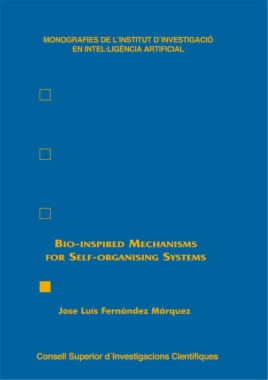Nowadays, emergent technologies are providing new communication devices (e.g. mobile phones, PDS's, smart sensors, laptops) that form complex infrastructures that are not widely exploited due to their requirements such scalability, real-time responses, or failure tolerance. To deal with these features, a new software tendency is to provide entities in the system with autonomy and pro-activity and to increment the interaction between them. This betting on incrementing interaction and decentralising responsibilities over entities, so-called self-organisation, provides systems with better scalability, robustness, and reduces the computation requirements of each entity. Biological systems have been adopted as a source of inspiration for Self-Organising systems. Since long, Self-organisation has been studied in biology showing a rich variety of collaborative behaviours, presenting interesting characteristic such as, scalability or failure tolerance. Nowadays, self-organising systems are applied to Multi-Agent Systems (MAS). A variety of self-organising, bio-inspired mechanisms have been applied in different domains, achieving results that go beyond traditional approaches. However, researchers usually apply these mechanisms in an ad-hoc manner. In this way, their interpretation, definition, boundary and implementation typically vary among the existing literature, thus preventing these mechanisms from being applied clearly and systematically to solve recurrent problems. This book provides a complete catalog of bio-inspired mechanisms for self-organising systems. The mechanisms presented are described using a software design pattern structure identifying when and how to use each pattern and describing the relation between the different mechanisms. This catalog of mechanisms is a step forward to engineering self-organising systems providing a systematic way to develop selforganisation systems. The effectiveness and generalisation the mechanisms presented in this book are demonstrated in three different domains: Dynamic Optimisation, Spatial Computing, and Sensor networks.
- Cover
- Title page
- Copyright page
- Dedicatoria
- Contents
- List of Figures
- Foreword
- Abstract
- Acknowledgements
- Chapter 1. Introduction
- 1.1 Motivation
- 1.2 Contributions
- 1.3 Book structure
- Chapter 2. Bio-inspired design patterns
- 2.1 A Model to Describe Bio-Inspired Design Patterns
- 2.2 Pattern Scheme
- 2.3 Basic Patterns
- 2.3.1 Spreading Pattern
- 2.3.2 Replication Pattern
- 2.3.3 Aggregation Pattern
- 2.3.4 Evaporation Pattern
- 2.3.5 Repulsion Pattern
- 2.4 Composed Patterns
- 2.4.1 Gradient Pattern
- 2.4.2 Digital Pheromone Pattern
- 2.4.3 Gossip Pattern
- 2.5 Top Layer Patterns
- 2.5.1 Morphogenesis Pattern
- 2.5.2 Quorum Sensing Pattern
- 2.5.3 Chemotaxis Pattern
- 2.5.4 Flocking Pattern
- 2.5.5 Foraging Pattern
- 2.6 Summary
- Chapter 3. Dynamic Optimisation
- 3.1 Background
- 3.1.1 Particle Swarm Optimisation
- 3.1.2 PSO in Dynamic Environments
- 3.1.3 PSO in Noisy functions
- 3.2 Evaporation Mechanism
- 3.2.1 Evaporation Mechanism
- 3.2.2 mQSOE
- 3.2.3 Dynamic Evaporation
- 3.3 Experiments
- 3.3.1 Experimental framework
- 3.3.2 Determining the evaporation factor
- 3.3.3 Subtraction versus multiplication as evaporation op-erator
- 3.3.4 Independence of peak heights and peak shifts
- 3.3.5 mQSO versus mQSOE
- 3.3.6 Filtering noise in mQSO
- 3.3.7 Dynamic Evaporation
- 3.4 Conclusions
- Chapter 4. Hovering Information inSpatial Computing
- 4.1 Introduction
- 4.2 Background
- 4.3 Hovering Information Concept
- 4.3.1 Hovering Information
- 4.3.2 Anchor Areas
- 4.3.3 Assumptions
- 4.4 Hovering Information Algorithms
- 4.4.1 Replication with Broadcast
- 4.4.2 Replication with Attractor Point
- 4.4.3 Cleaning
- 4.4.4 Repulsion
- 4.4.5 Broadcast Repulsion
- 4.4.6 Attractor Point Repulsion
- 4.5 Simulation Results
- 4.5.1 Metrics
- 4.5.2 Indoor Scenario
- 4.5.3 Outdoor Scenario
- 4.5.4 Analysis of algorithms
- 4.6 Conclusions
- Chapter 5. Detecting Di use Event Sources in Noisy WSN. Environments
- 5.1 Introduction
- 5.2 Related Work
- 5.3 Sleep/Wake Modes
- 5.4 Our Approach
- 5.4.1 Sensors
- 5.4.2 Mobile Agents
- 5.5 Experiments
- 5.5.1 Varying the number of sensors in WSN
- 5.5.2 Quality of Convergence
- 5.5.3 Varying the Noise Factor
- 5.5.4 Varying Local Exploration
- 5.5.5 Varying Global Exploration
- 5.5.6 The Exploration Cost
- 5.5.7 Tolerance to WSN failures
- 5.6 Conclusions
- Chapter 6. Conclusions and Future Work
- 6.1 Publications related to this research
- Bibliography
- Appendix A. Hovering Information
- Back Cover

